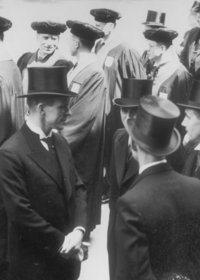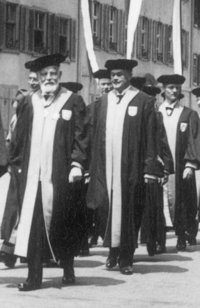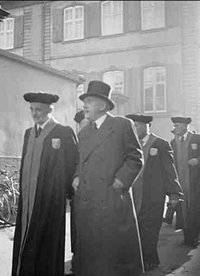The debate on academic gowns in the twentieth century
The debate during the 1920s and 1930s over reintroducing academic gowns, after the University of Basel had abolished gowns for the second time during the Helvetic Republic, was intense and emotional.
In the fifteenth century, professors wore gowns of various colors depending on their faculties. Medieval universities, which had their origins in cathedral schools and the monastic studies of clerics, were heavily influenced in their early centuries by clerical structures. Thus, the long gown as clerical attire was also the normal outer garment for faculty. This “Catholic” tradition was deliberately discontinued in Basel during the Reformation. After that, professors, like all officeholders, wore black robes. However, these official robes were abolished in Basel along with garb of civil authorities in 1798–99, during the Helvetic Republic, as they were seen to emphasize a distance between citizens and government officials that ostensibly contradicted demands for equality. It was not until the 1920s that a debate about the reintroduction of gowns then resurfaced in Switzerland: Swiss professors felt “somewhat out of place” in their ordinary dress, especially at events abroad.
The rectorate sought a legal opinion on the question; six pages long, it concluded that the university was indeed entitled to permit its members to wear gowns, but it could not compel them to do so, and certainly not at their own expense. In the 1930s, a conference was convened at the suggestion of the University of Basel, where the rectors of the universities of Basel, Bern, Geneva, and Lausanne discussed the issue.
Whether the representatives from the University of Zurich were not invited because a young, reform university was not expected to have an interest in traditions, or whether they were absent for scheduling reasons, is not clear from the records. In any case, the University of Zurich was not represented at the event. Haller and Rappard, the rectors of Bern and Geneva, feared that the idea of academic gowns would not be well received at their universities “as it would be considered undemocratic and outdated,” but they decided to start the discussion at their universities nonetheless. Lausanne had already decided to reintroduce the garments; Basel’s rector Labhart was optimistic.
“Invention of Tradition,” 1939
The Senate of the university did in fact decide to introduce academic gowns for the inauguration ceremony of the new Kollegienhaus in 1939, but the decision was now encountered protest from within the university. Concerns were raised about “an undesirable distancing from the people”; or that the gowns might evoke “thoughts of a carnival clique”; that “the times are too serious for such jokes”; that the money could be better spent; and, above all, that the gowns contradicted the tradition of “old Basel simplicity.”
The protest was unsuccessful. The only concession made was that all gowns should be the same, distinguished only by the colors of the faculties, but not by rank: full professors, extraordinary (associate) professors, and habilitated private lecturers would all wear the same gowns. At the inauguration ceremony, the new gowns were presented for the first time. What was soon to be considered an old tradition was thus newly “invented” after more than 400 years.





